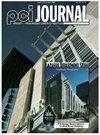Influence of structural form on hydration-heat-induced temperature rise of precast concrete lining segments for a metro transit station
IF 0.9
4区 工程技术
Q4 CONSTRUCTION & BUILDING TECHNOLOGY
引用次数: 0
Abstract
This paper describes research on the effect of structural form on hydration-heat-related changes in large-scale precast concrete lining segments. These segments of mass concrete were used in the construction of an underground metro transit station in Changchun, China, a location where conventional cast-in-place construction is interrupted for months by cold winter weather. Heat of hydration analysis of closed-cavity and solid lining segments was conducted using the finite element method (FEM). Two ambient temperatures of 25°C and 10°C (77°F and 50°F) were selected to simulate segment manufacturing conditions in summer and winter, respectively. The FEM and selected parameters were found to be reasonable because the numerical predictions and experimental observations from the closed-cavity segment were consistent. At both of the ambient temperatures, the maximum internal concrete temperature of the closed-cavity segment was much lower than that in the solid one and the temperature distribution in the closed-cavity segment was more uniform. As a result, thermal stress was lower in the closed-cavity segment than in the solid segment, which reduced the risk for cracking. The closed-cavity form of the lining segments enhanced the structural integrity and durability, and the ability to prefabricate these segments in cold ambient temperatures effectively accelerated construction on this project.某轨道交通车站结构形式对预制混凝土衬砌管片水化热致温升的影响
本文研究了结构形式对大型预制混凝土衬砌管片水化热相关变化的影响。这些大块混凝土被用于建设中国长春的地下地铁中转站,该地点的传统现浇施工因寒冷的冬季天气而中断了数月。采用有限元法对封闭空腔和固体衬砌管片进行水化热分析。选取25°C和10°C(77°F和50°F)两种环境温度分别模拟夏季和冬季的分段制造条件。数值预测结果与封闭空腔段的实验结果一致,表明有限元计算和所选参数是合理的。在两种环境温度下,封闭孔洞段混凝土内部最高温度远低于实心孔洞段,且封闭孔洞段内温度分布更为均匀。因此,闭合腔段的热应力低于固体段,从而降低了开裂的风险。衬砌管片的闭腔形式提高了结构的完整性和耐久性,并且在寒冷的环境温度下预制这些管片的能力有效地加快了该项目的施工。
本文章由计算机程序翻译,如有差异,请以英文原文为准。
求助全文
约1分钟内获得全文
求助全文

 求助内容:
求助内容: 应助结果提醒方式:
应助结果提醒方式:


